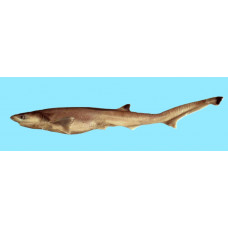Latin name
Heptranchias perlo
Other name
One-finned shark, perlon shark, sevengill cow shark, sharpsnouted sevengill or slender sevengill.
Identification
These sharks have a slender, spindly body with a narrow, pointed head. The large oval eyes are horizontally elongated and the pupils fluoresce blue-green in live sharks. The mouth is narrow and strongly curved. There are 9-11 teeth on each side of the symphysis on the upper jaw and 5 teeth on the lower jaw. The narrow upper teeth are hook-shaped and have small lateral serrations. The broad lower teeth are comb-like with a protruding anterior serration. Unlike most sharks, have 7 pairs of long gill slits that terminate below the pharynx.
Features of fish fins
Dorsal spines (total): 0; Anal spines: 0.
They have only one dorsal fin, located between the pelvic and anal fins. It has a straight anterior margin, a slightly rounded tip and a concave caudal margin. There is no spine at the base. The pectoral fins are small with a concave caudal edge. Anal fin very small with straight edges. Caudal peduncle long, distance between dorsal fin and caudal fin base more than 2 times the length of the dorsal fin base. Denticles very thin, transparent, longer than wide, with a central ridge ending in a spine, and small projections on the sides.
Fish colouring
Colour from brownish grey to olive, belly lighter. Some individuals have scattered dark markings on the back, and pale fin edges are possible. Juveniles have dark spots on the flanks and the edges of the dorsal and upper lobe of the caudal fin are darker than the base colour.
Distribution
Widespread in tropical and subtropical oceans and less common in temperate and warm oceans, except in the northeastern Pacific. In the western Atlantic they occur from North Carolina to Cuba and the northern Gulf of Mexico, and in southern Brazil and Argentina. In the eastern Atlantic they are found from Morocco to Angola and in the Mediterranean. In the Indian Ocean, their range extends to the coast of South Africa, southern Mozambique, Aldabra Island and southwest India. In the Pacific they are found in the coastal waters of Japan, China, Indonesia, Australia, New Zealand and northern Chile.
Habitat
These bottom-dwelling sharks are found on continental and island shelves and the upper part of the continental slope at depths ranging from 27 to 720 metres, sometimes rising to the surface or dropping below 1000 metres.
Size
The average length of a sharpnose sevengill shark is 60-120 cm, with a maximum recorded length of 1.4 m.
Behavior
These sharks are excellent swimmers and hunt mainly at night. They can be preyed upon by larger shark species.
Food and feeding habits
Despite their small size, sharpnose sevengill sharks are top predators in the ecosystem in which they live. In the Great Meteor Seamount, Eastern Atlantic, they typically prey on bony fish and cephalopods and, to a lesser extent, cartilaginous fish. Off Tunisia, crustaceans are the second most important food item after bony fish. In Australian waters, small sharks prey on Lepidorhynchus denticulatus, while large sharks prefer snake mackerel and cutlassfish.
Reproduction
These sharks reproduce by oviposition. Breeding is not seasonal. There are 9 to 20 newborns in a litter of about 26 cm in length. Males and females reach sexual maturity at lengths of 75-85 cm and 90-100 cm respectively. Sexual maturity in males is indicated by the production of mucus on the pterygopodia.
Fishing
Sharpnosed sevengill sharks are caught as by-catch in commercial deep-sea trawls or longlines. The meat of the sharks caught is used as food and the waste is used to produce fishmeal.
Relationship with a person
This species is not believed to pose a threat to humans. However, sharks that are caught can be aggressive and may bite fishermen.
| Classification | |
| Phylum | Chordata |
| Class | Chondrichthyes |
| Squad | Hexanchiformes |
| Family | Hexanchidae |
| Genus | Heptranchias |
| Species | H. perlo |
| Features | |
| Conservation status | Near Threatened |
| Habitat | Bottom |
| Life span, years | No information |
| Maximum body weight, kg | No information |
| Maximum length, cm | 140 |
| Sailing speed, m/s | No information |
| Threat to people | Edible |
| Way of eating | Predator |

